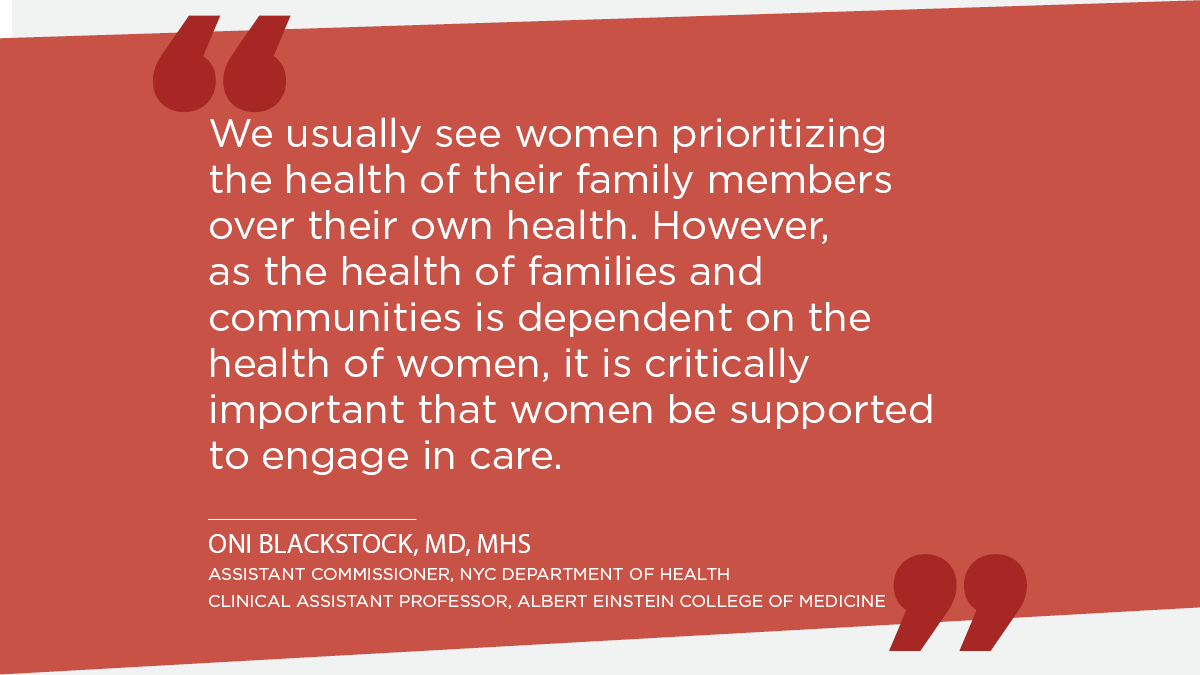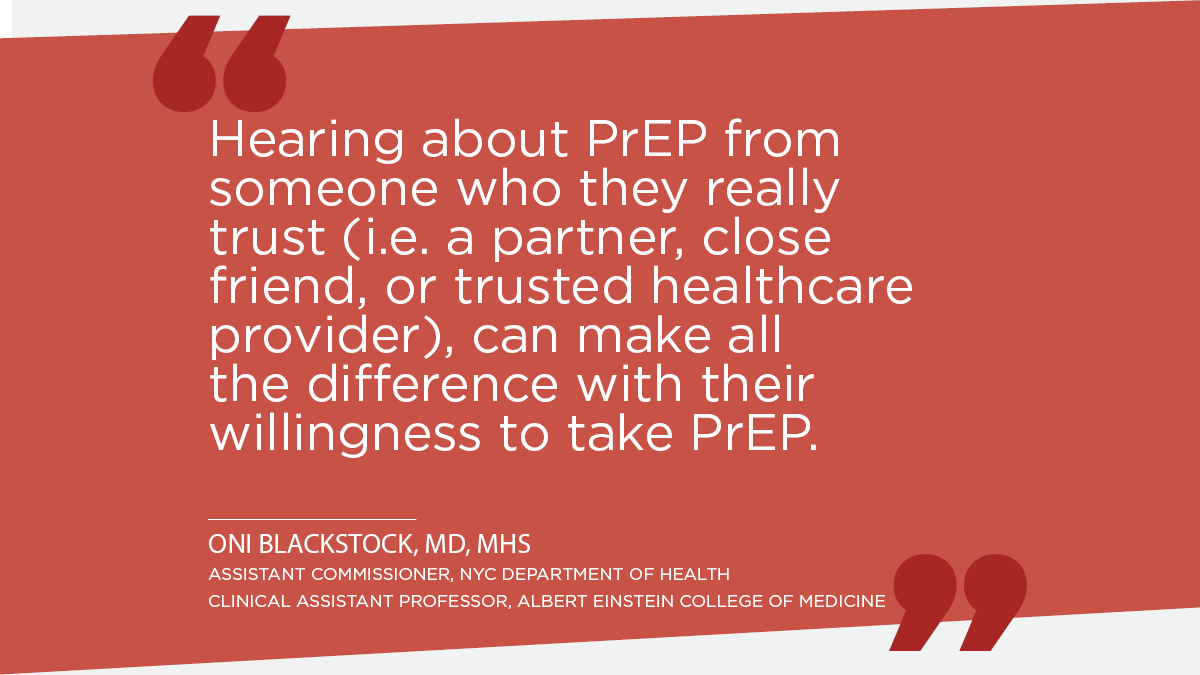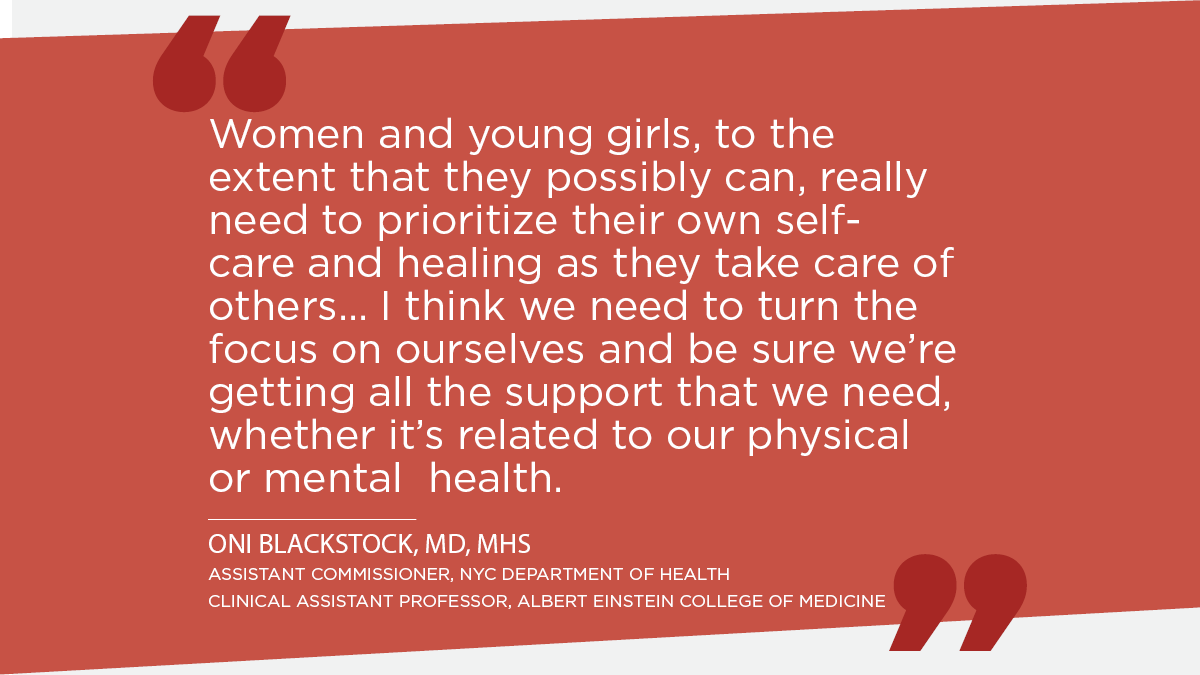Oni Blackstock, MD, MHS, Assistant Commissioner, NYC Department of Health; Clinical Assistant Professor, Albert Einstein College of Medicine
Q: One of the main focuses of your work has been improving engagement in clinical care and health outcomes for women with HIV. How did you become interested in this particular aspect of HIV research and care?
I became interested in health outcomes for women with HIV due to the central role that women hold in families. Women are often the primary caregivers for their families. As an HIV clinician, I have seen my patients often come in with their little children or an older family member who they are taking care of. We usually see women prioritizing the health of their family members over their own health. However, as the health of families and communities is dependent on the health of women, it is critically important that women be supported to engage in care. The unique barriers that women face while engaging in HIV care captivate me, as well as my obvious interest as a woman myself. So this really became a focus of my clinical work and my research.
Q: Although new HIV diagnoses have been declining for women, they still comprised 1/5 of all new diagnoses in 2017. What is the NYC DOH doing to address new HIV diagnoses among women?
The New York City DOH is raising awareness and advocating for women’s HIV care through the Women’s Advisory Board and the Living Sure campaign. The Women’s Advisory Board is a diverse group of dedicated, passionate women leaders in New York City who have a lot of experience serving and empowering women in their communities. Some of the work that we are doing includes raising awareness about pre-exposure prophylaxis, otherwise known as PrEP, through the Living Sure Campaign.
As we are seeing these encouraging declines, there are still stark racial/ethnic disparities. Almost 90 percent of women in New York City who were diagnosed with HIV are either Black and/or Latina, so there is still a great amount of work to be done. It is really important for us in that our campaigns reflect the diversity of women across New York City, especially those who are impacted by HIV, and include sex-positive, empowering messaging to ensure that women have the knowledge and the tools to have a safe and pleasurable sex life.
Q: You were recently awarded a CDC grant to improve HIV prevention, especially among women who are most at risk. What strategies are most effective at getting women who need it on PrEP?
Education, peer counseling, and access are important in getting women who may benefit from PrEP on it. Through my research, I have also found that for women, who is telling them about PrEP is very important. To illustrate that point, I did a qualitative study of women who ended up being prescribed PrEP to understand what their pathways to PrEP were. We found out that, hearing about PrEP from someone who they really trust (i.e. a partner, close friend, or trusted healthcare provider), can make all the difference with their willingness to take PrEP.
With the CDC grant I received in my previous job, we focused on using peers, cisgender and transgender women, to do outreach around PrEP education and counseling, and to link them to a clinic that offers PrEP to women. We were out in the field, engaging women at mobile syringe exchange sites and a drop-in center for women involved in sex work.
Q: Your work has particularly focused on marginalized women such as sex workers, trans women, injection drug users, etc. How are these women being underserved and what needs to be done to address their risk for HIV?
We are engaging with grassroots organizations, and building organizational capacity within the Health Department in order to reach and better support marginalized populations. Care is not being provided to these women in ways they can access it, so changing the care system is necessary to address their risk.
We can’t expect women to come to the clinic and ask for PrEP so we need to think about innovative delivery models for PrEP. The intervention I developed offers a PrEP clinic appointment as well as referrals for mental health, housing, and other needs. But, it is still hard to get women in the door, so we need to go where women are. That may include PrEP delivery in a mobile van. If women are out doing street-based sex work, then we need to go out there — offer them the PrEP there and screen for sexually transmitted infections – as opposed to expecting people to make it all the way to a clinic.
 Women of trans experience often have challenges finding employment because of transphobia or trans antagonism. They’re being marginalized, and they have no other choice but to engage in sex work in order to survive, so the Health Department is raising awareness for women and people of trans experience. Our Health Department supports four trans organizations to build organizational capacity and to help them expand the services that they provide. These are organizations that don’t necessarily provide HIV-related services. They offer things like housing and employment. But by addressing these larger social and contextual factors, we can better engage with women who partake in sexual and drug use behaviors that might put them at risk for HIV.
Women of trans experience often have challenges finding employment because of transphobia or trans antagonism. They’re being marginalized, and they have no other choice but to engage in sex work in order to survive, so the Health Department is raising awareness for women and people of trans experience. Our Health Department supports four trans organizations to build organizational capacity and to help them expand the services that they provide. These are organizations that don’t necessarily provide HIV-related services. They offer things like housing and employment. But by addressing these larger social and contextual factors, we can better engage with women who partake in sexual and drug use behaviors that might put them at risk for HIV.
Q: This National Women and Girls HIV/AIDS Awareness Day what is your message to women and girls at risk for or living with HIV?
Prioritize your health. Throughout my work, I’ve found that women often take care of everyone else but themselves. Women and young girls, to the extent that they possibly can, really need to prioritize their own self-care and healing as they take care of others. There are a lot of messages that make women think that other people, other things, should be their priority. I think we need to turn the focus on ourselves and be sure we’re getting all the support that we need, whether it’s related to our physical or mental health.




